Continental Army Worksheets
Do you want to save dozens of hours in time? Get your evenings and weekends back? Be able to teach about the Continental Army to your students?
Our worksheet bundle includes a fact file and printable worksheets and student activities. Perfect for both the classroom and homeschooling!
Resource Examples
Click any of the example images below to view a larger version.
Fact File
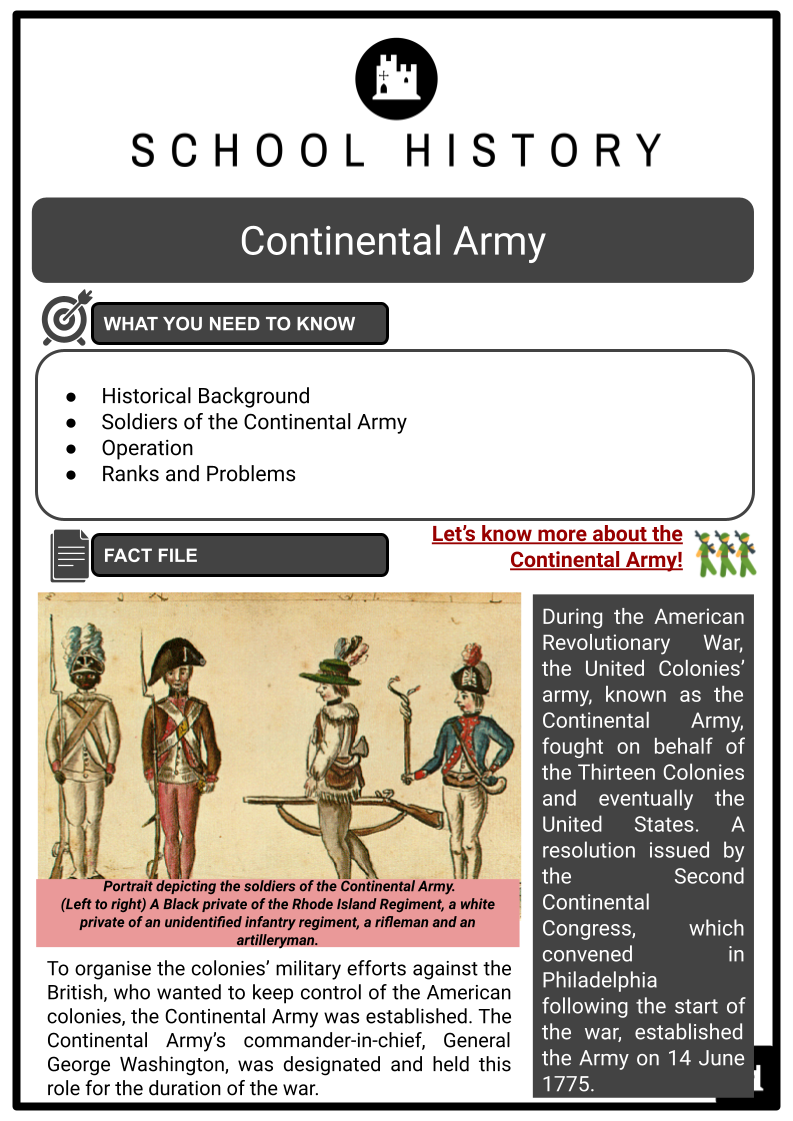
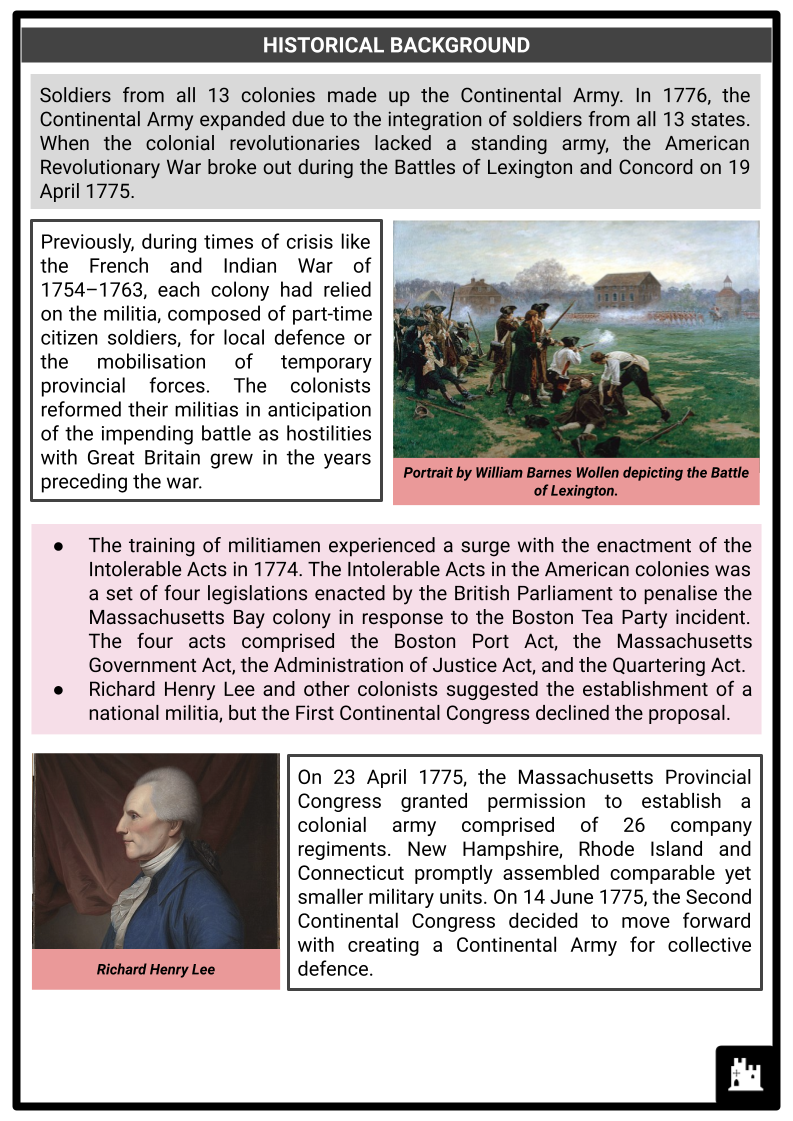
Student Activities
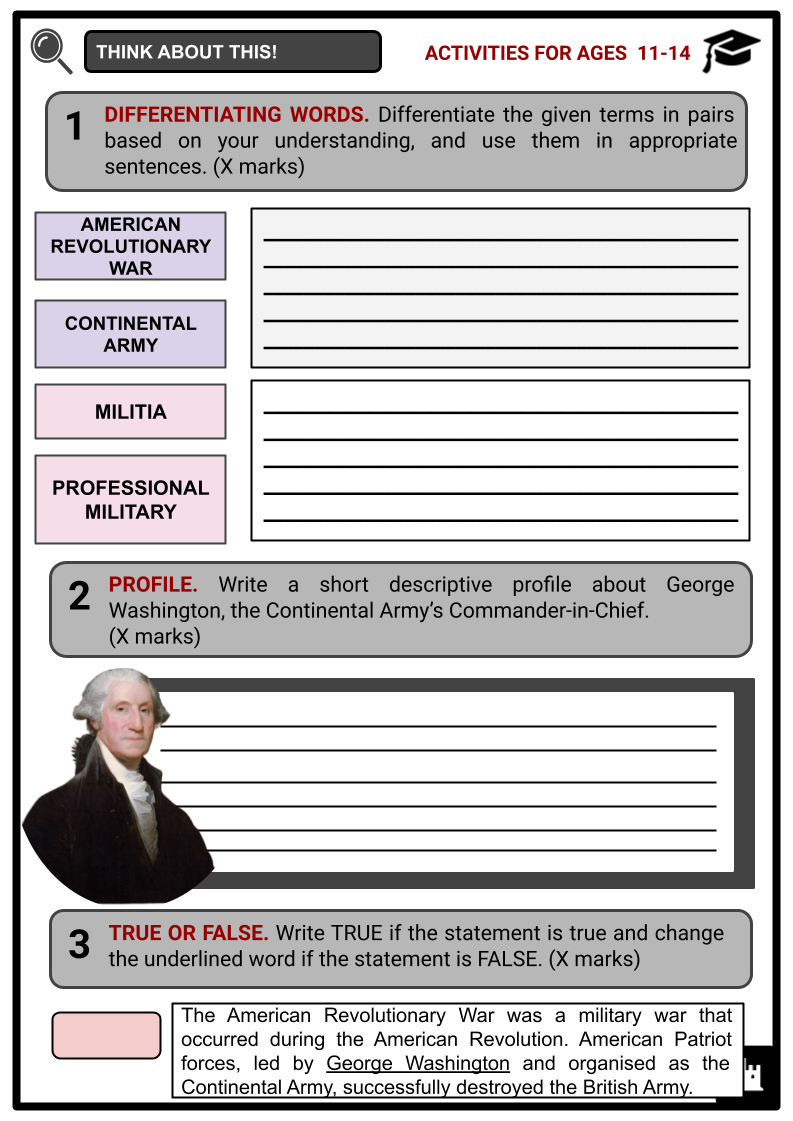
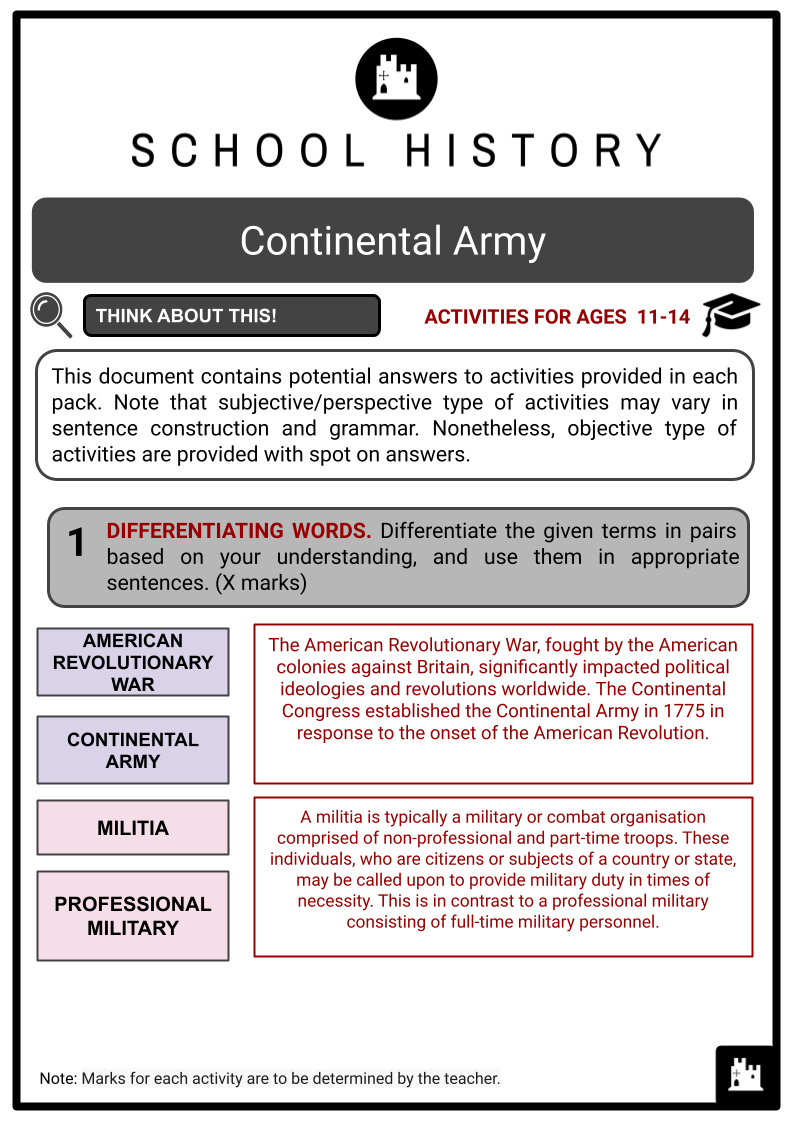
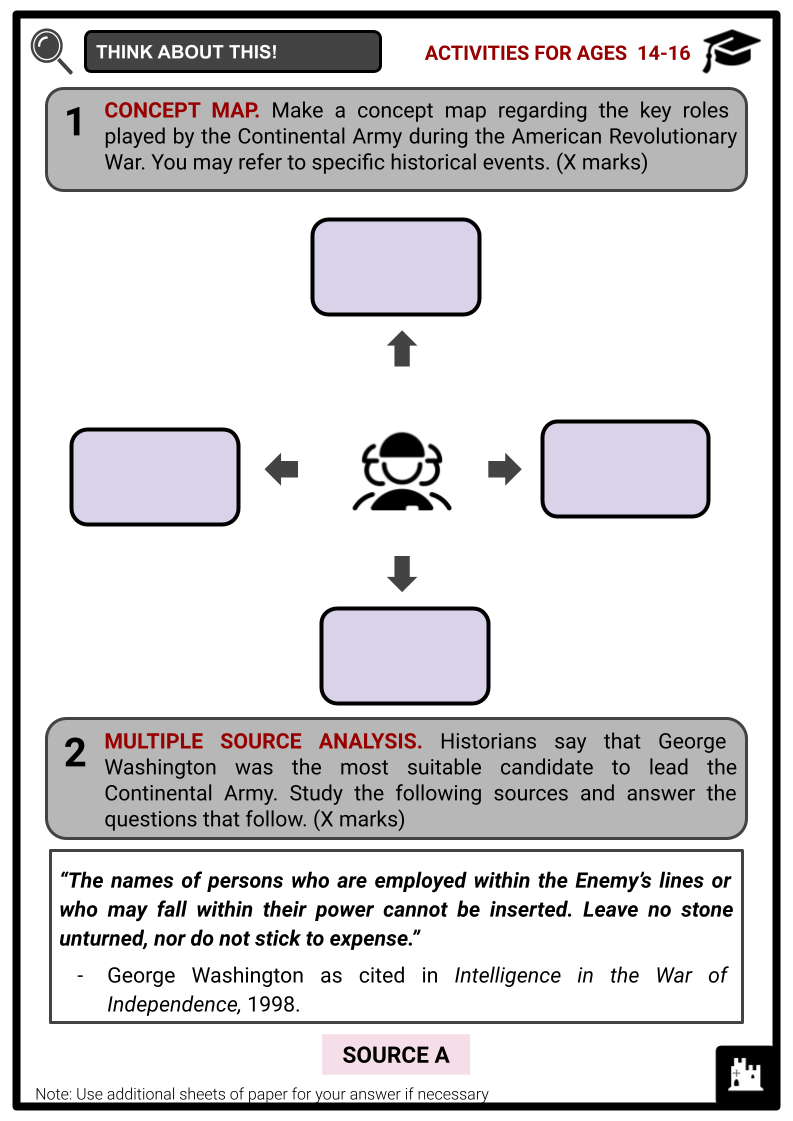
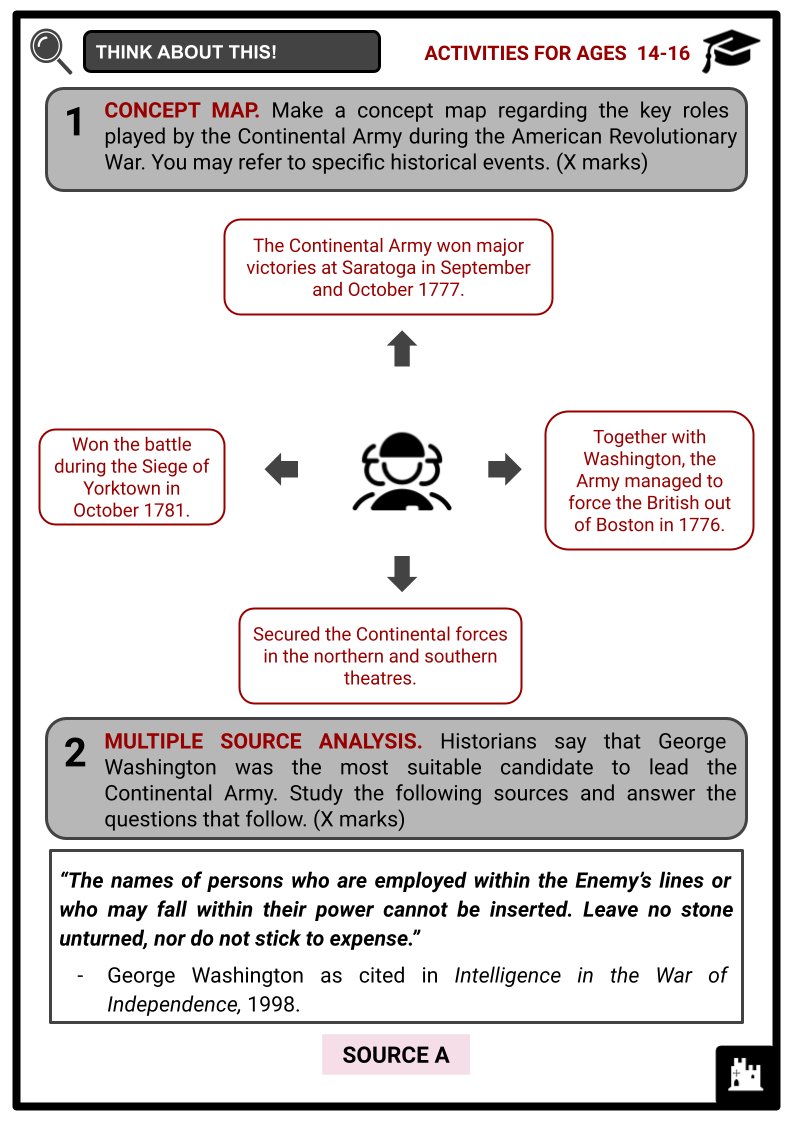
Summary
- Historical Background
- Soldiers of the Continental Army
- Operation
- Ranks and Problems
Key Facts And Information
Let’s know more about the Continental Army!
During the American Revolutionary War, the United Colonies’ army, known as the Continental Army, fought on behalf of the Thirteen Colonies and eventually the United States. A resolution issued by the Second Continental Congress, which convened in Philadelphia following the start of the war, established the Army on 14 June 1775.
To organise the colonies’ military efforts against the British, who wanted to keep control of the American colonies, the Continental Army was established. The Continental Army’s commander-in-chief, General George Washington, was designated and held this role for the duration of the war.
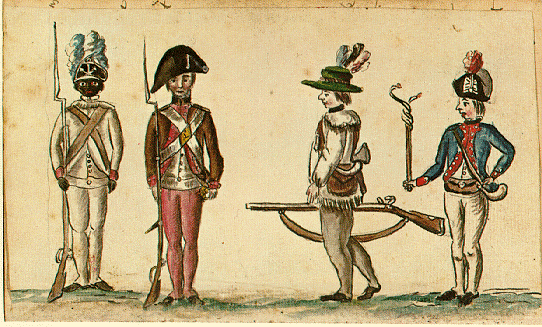
HISTORICAL BACKGROUND
- Soldiers from all 13 colonies made up the Continental Army. In 1776, the Continental Army expanded due to the integration of soldiers from all 13 states. When the colonial revolutionaries lacked a standing army, the American Revolutionary War broke out during the Battles of Lexington and Concord on 19 April 1775.
- Previously, during times of crisis like the French and Indian War of 1754–1763, each colony had relied on the militia, composed of part-time citizen soldiers, for local defence or the mobilisation of temporary provincial forces. The colonists reformed their militias in anticipation of the impending battle as hostilities with Great Britain grew in the years preceding the war.
- The training of militiamen experienced a surge with the enactment of the Intolerable Acts in 1774. The Intolerable Acts in the American colonies was a set of four legislations enacted by the British Parliament to penalise the Massachusetts Bay colony in response to the Boston Tea Party incident. The four acts comprised the Boston Port Act, the Massachusetts Government Act, the Administration of Justice Act, and the Quartering Act.
- Richard Henry Lee and other colonists suggested the establishment of a national militia, but the First Continental Congress declined the proposal.
- On 23 April 1775, the Massachusetts Provincial Congress granted permission to establish a colonial army comprised of 26 company regiments. New Hampshire, Rhode Island and Connecticut promptly assembled comparable yet smaller military units. On 14 June 1775, the Second Continental Congress decided to move forward with creating a Continental Army for collective defence.
- Additionally, the Continental Army organised the initial ten companies of Continental troops on a one-year term of service, consisting of riflemen hailing from Pennsylvania, Maryland and Virginia, who were intended to serve as light infantry. In June 1775, Congress unanimously chose George Washington as Commander-in-Chief.
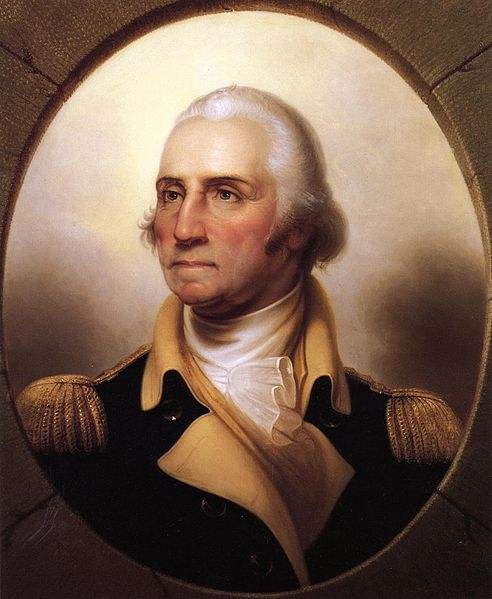
- Washington accepted the position and served throughout the war without receiving any payment, save for reimbursement of expenses. As the Continental Congress gradually took on the duties and position of a governing body for an independent nation, there was much discussion about the function of the Continental Army.
- While certain Americans generally disliked having a permanent army, the demands of the battle against the British necessitated the need for a well-structured and organised contemporary force. Consequently, the army underwent various discrete periods, marked by the official disbandment and restructuring of formations.
- In general, the Continental forces were comprised of multiple consecutive armies or establishments:
- Washington organised the Continental Army of 1775, which consisted of the original New England Army, into 3 divisions, 6 brigades and 38 regiments. Major General Philip Schuyler deployed his ten troops in New York to launch an invasion into Canada.
- The Continental Army of 1776 underwent reorganisation following the expiration of the first enlistment period of the soldiers who served in the 1775 army. After accepting the Commander-in-Chief role, Washington promptly presented his suggestions to the Continental Congress.
- The formation of the Continental Army from 1777 to 1780 resulted from significant changes and political choices made in response to the British intention to deploy large military forces to suppress the American Revolution.
- The Continental Army faced its most severe crisis from 1781–1782 in the American Revolutionary War. The bankruptcy of Congress posed a significant challenge in replenishing the soldiers whose three-year contracts had ended.
SOLDIERS OF THE CONTINENTAL ARMY
- Upon Washington’s assumption of command, the Continental Army was not essentially a cohesive military force. Instead, it was an inadequately organised and loosely organised group of militias and citizen soldiers under the different states’ control.
- There were no set rules for exercising coordinated authority, providing supplies and food to the troops, transportation, or any other necessary responsibilities for a field army. Due to the inadequate and frustratingly sluggish communication methods of the 18th century, obtaining the necessary clearance from the Continental Congress for every matter took time.
- Given these circumstances, engaging in combat against the formidable British army was an immense undertaking. Notwithstanding these obstacles, Washington managed to organise this diverse and disorganised group into 3 divisions, 6 brigades and 38 regiments. Initially, he used the militia of Schuyler’s ten battalions in New York – in a failed endeavour to invade Canada.
- Between 1781 and 1782, authorities and military personnel supporting the Patriot cause in the Southern Colonies consistently enacted strategies that involved offering enslaved people as incentives to recruiters who successfully enlisted a specific number of volunteers in the Continental Army.
- The members of both the Continental Army and the state militias were primarily yeoman farmers.
- The Continental Army achieved racial integration, a state that would only be seen again in the United States Army in the late 1940s. During the American Revolution, enslaved Africans were offered emancipation in return for their military service by both the Continental and British troops.
- Around 6,600 individuals belonging to racial minority groups, including Black people, Indigenous people and those of mixed race, served in the colonial forces. These individuals constituted one fifth of the Northern Continental Army.
- Aside from the regular troops of the Continental Army, state militia units were also enlisted for temporary duty and participated in various military operations for the entire duration of the war.
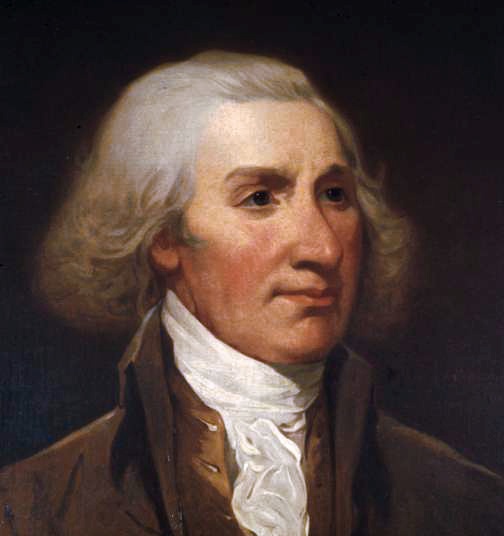
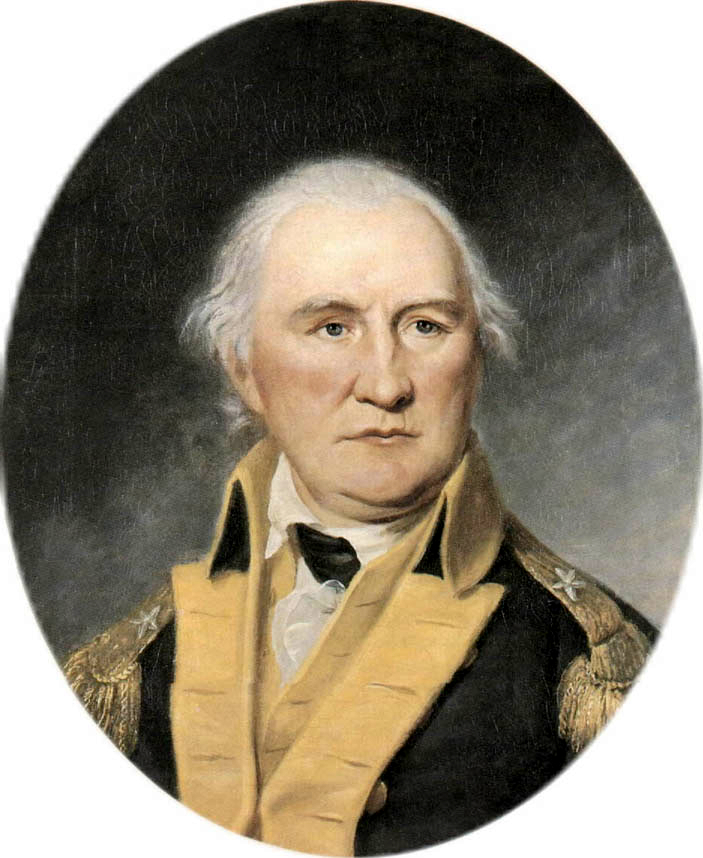
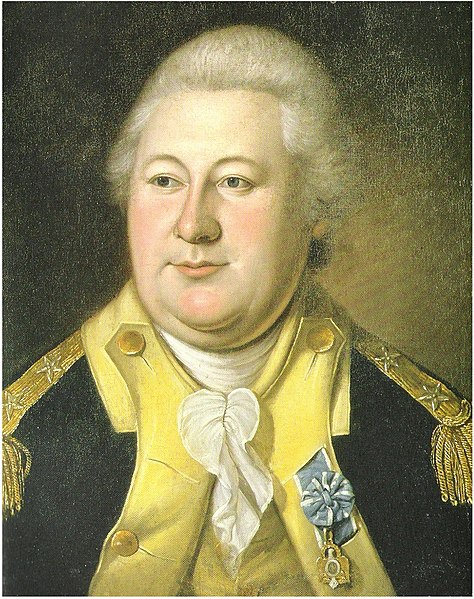
- The militia groups occasionally functioned autonomously from the Continental Army, but local militias were frequently summoned to assist and reinforce the regular troops of the Continental Army during military engagements.
- General Daniel Morgan strategically incorporated the tendency of the militia troops to flee prematurely into his plan during the Battle of Cowpens in 1781, thus deceiving the British forces.
- States were allocated the financial obligation of providing salary, food, shelter, clothes, weaponry and other equipment to designated units as part of their establishment. States varied in their level of compliance with these responsibilities. Persistent financing challenges and morale problems plagued the battle. Consequently, the army provided meagre wages, frequently spoiled rations, arduous labour, extreme temperatures, inadequate attire and housing, strict punishment, and a significant risk of injury or death.
- Washington assigned James Mease, a merchant from Philadelphia, the challenging responsibility of providing clothing for the continentals. Mease collaborated closely with state-appointed agents to procure garments and materials, such as cow hides, to manufacture apparel and footwear for soldiers.
- Mease ultimately stepped down in 1777 and significantly undermined the Clothing Department’s structure. Subsequently, the soldiers of the Continental Army frequently suffered from inadequate clothing, a scarcity of blankets and a lack of footwear.
- The issues about clothes and footwear for soldiers were frequently not due to insufficient supply but rather stemmed from organisational and logistical shortcomings. The appointment to reorganise the Board of War was made to streamline the apparel supply chain. During this period, they sought assistance from France, and for the rest of the war, clothing was obtained through overseas purchases.
OPERATIONS
- During the siege of Boston in June 1775, the Continental Army stationed at Cambridge, Massachusetts, is believed to have consisted of between 14,000 and 16,000 soldiers from New England. However, the real number was as low as 11,000 due to desertion. Before Washington’s arrival, Artemas Ward was in control.
- The British contingent in Boston was growing due to the arrival of new troops.
- The British exerted control over Boston and safeguarded it with their naval force. However, they refrained from contesting the American dominance over New England due to their numerical disadvantage.
- Washington appointed Henry Knox to lead the artillery retrieval mission from a deserted British fort in upstate New York. Knox successfully transported the cannon through the snow and strategically positioned them in the hills surrounding Boston in March 1776.
- Over the following five years, the primary forces of the Continental and British armies engaged in military operations against each other in the regions of New York, New Jersey and Pennsylvania. These military operations encompassed significant engagements such as Trenton, Princeton, Brandywine, Germantown and Morristown, among several more.
- During the winter of 1777–1778, the Continental Army significantly improved training and discipline, mainly because of the inclusion of Baron von Steuben, a Prussian specialist. This upgrade brought the army up to the standards observed in modern European militaries.
- Washington consistently regarded the Army as a provisional solution. It tried to uphold civilian authority over the military, a stance shared by the Continental Congress despite some minor disputes on implementing this principle.
- In 1781, the French significantly contributed to Washington’s Army by providing more troops from a French expeditionary force led by Jean-Baptiste Donatien de Vimeur, Comte de Rochambeau, as well as a fleet from the French navy commanded by the Jacques-Melchior Saint-Laurent, Comte de Barras. Washington successfully concealed his actions, allowing him to transfer the combined forces to Virginia without detection by the British commanders stationed in New York.
- The outcome of the siege of Yorktown led to the capture of the primary British invasion force in the southern region.
RANKS AND PROBLEMS
- In the early stages of the American Revolutionary War, the Continental Army used ribbons, cockades and epaulettes of different colours as a makeshift way to indicate ranks.
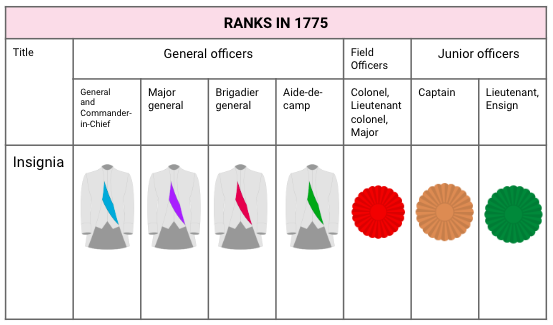
- The decisive triumph at Yorktown in 1781, with the invaluable assistance of the French army and naval, effectively concluded the war. In his 1783 Farewell Order, Washington expressed gratitude to his officers and soldiers. He commended the Army’s unification of many states into a cohesive and patriotic unit, symbolising their collective commitment in times of both conflict and harmony.
- On 23 December 1783, Washington relinquished his position as Commander-in-Chief and submitted his commission to Congress. The American Revolutionary War concluded on 14 January 1784, upon Congress’s ratification of the peace accord made in Paris on 3 September 1783. Washington suggested the establishment of a perpetual standing army, a structured militia, weapon storehouses and a military institution. However, Congress declined this proposal.
Image Sources
Frequently Asked Questions
- What was the Continental Army?
The Continental Army, established by the Second Continental Congress in 1775, was the unified military force of the thirteen American colonies during the American Revolutionary War.
- Who was the Commander-in-Chief of the Continental Army?
General George Washington was appointed Commander-in-Chief of the Continental Army in 1775 and led the army throughout most of the Revolutionary War.
- What were the major battles fought by the Continental Army?
The Continental Army fought in numerous battles during the Revolutionary War, including the Battle of Bunker Hill, the Siege of Boston, the Battles of Saratoga, the Battle of Trenton, and the Battle of Yorktown.
